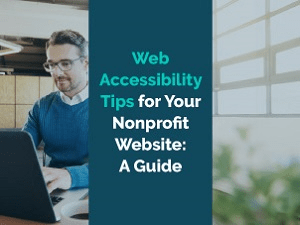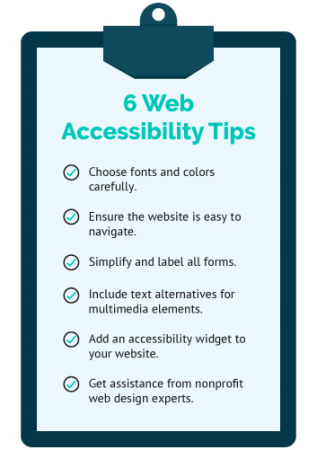
After months of designing, planning, and anticipation, it’s finally live—your nonprofit’s new website!
It’s probably tempting to call it a day when it comes to working on the website. After all, everything seems to be working fine, and you’re eager to start using the site to help with your marketing efforts and fundraising strategy.
But you shouldn’t wash your hands of your website work just yet. To get your website up to par with the best nonprofit websites out there, you need to ensure that it’s fully accessible to everyone who uses it.
In this guide, we’ll help you optimize your website for accessibility by providing you with all the background you need to know, as well as some actionable tips.
A Brief Overview of Web Accessibility
According to the World Wide Web Consortium (W3C), “Web accessibility means that websites, tools, and technologies are designed and developed so that people with disabilities can use them.”
Accessible websites can also benefit people without disabilities, such as those with temporary disabilities (like a broken wrist), situational limitations (not being able to listen to the audio on a video), or slow internet connections.
In short, web accessibility is important because it helps everyone get the most out of the web, regardless of their abilities, their location, or the tools they have to work with.
To ensure your website is accessible, adhere to the guidelines set forth by the W3C called the Web Content Accessibility Guidelines (WCAG). The main tenets of these guidelines are as follows:
- Perceivable: Web content should be easily consumable for all users.
- Operable: Websites should allow users to easily navigate and find what they’re looking for.
- Understandable: Website copy should be readable and understandable. And if any tools on a website require user input, it should be easy for users to see and correct any mistakes.
- Robust: Websites should be compatible with assistive technologies like screen readers.
Having a fully accessible website will take some effort, and we’ll dive into our tips for achieving this below. First, let’s explore why web accessibility should be a priority for your nonprofit.
Why Having an Accessible Website Matters
Making your organization’s website accessible isn’t just a nice thing to do. In fact, accessibility is essential for a few different reasons.
Specifically, prioritizing web accessibility allows you to:
- Comply with legal requirements. More and more, courts are considering websites to be public accommodations that must comply with the Americans with Disabilities Act (ADA). This means that applying accessibility best practices to your website can help protect your organization from potential future legal issues.
- Increase your nonprofit’s reach. By opening up your website to more users, you can reach a wider audience with your marketing efforts and encourage more people to support your work.
- Establish your nonprofit as an inclusive organization. People want to support organizations that align with their values and treat their communities well. By making your website accessible, you communicate to your supporters that you truly care about being inclusive and inviting everyone to get involved with your cause.
In addition to these reasons, accessibility aligns with all of the other best practices you’ve leaned into to create your website in the first place and helps ensure you’re going to get the most out of your site.
6 Tips for Making Your Website More Accessible
Though web accessibility is important and has far-reaching benefits for your nonprofit, there’s no need to get overwhelmed as you begin the journey to making your site more accessible. Here are six quick tips that can help you get started:

- Choose fonts and colors carefully. Make your content easy to look at and read. Start by choosing a simple font. (Sans serif options are typically best.) Also, consider the colors on your site and whether they offer a high level of contrast.
- Ensure the website is easy to navigate. Create a clear navigation menu that orders the resources on your website from most to least important. Ideally, this menu should be accessible from any point on your website. Additionally, ensure that your website is easily navigable by keyboard.
- Simplify and label all forms. Every form on your website should be easy to fill out. Shorten your forms so that they only ask for essential information, and clearly label each field so users know what information to supply. Configure your forms to clearly mark mistakes like blank fields and provide instructions for correcting them.
- Include text alternatives for multimedia elements. Start by adding alternative text (also known as alt text) to the images on your website. Additionally, any videos added to your site should have subtitles and an accompanying transcript.
- Add an accessibility widget to your website. Use your chosen website builder to add an accessibility widget to your site that empowers users to change font size, adjust color contrast, or highlight important text.
- Get assistance from nonprofit web design experts. A nonprofit web design company like Cornershop Creative can easily help your nonprofit identify its web accessibility shortcomings and implement positive changes—all while balancing your organization’s goals for the look and function of its site!
Making your website fully accessible won’t be a one-time task. As you add content and make updates to your site over time, you’ll need to consistently revisit the accessibility of your website and make necessary adjustments. One great tool for monitoring this is Google Lighthouse, which can quickly audit and highlight accessibility issues for you.
Getting a new nonprofit website up and running (or revamping your current site) is always exciting. However, to ensure that you can truly grow your nonprofit's online presence in an inclusive and effective way, you need to prioritize web accessibility.
Use this guide to get started, and remember to turn to nonprofit web design experts if you need support!
- Familiarize yourself with the WCAG guidelines and why web accessibility matters for nonprofits.
- Implement these six tips for making your website more accessible.
- Get professional help as needed and continuously monitor the level of accessibility your website offers.